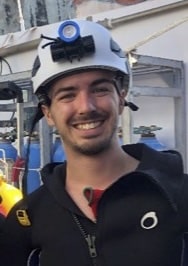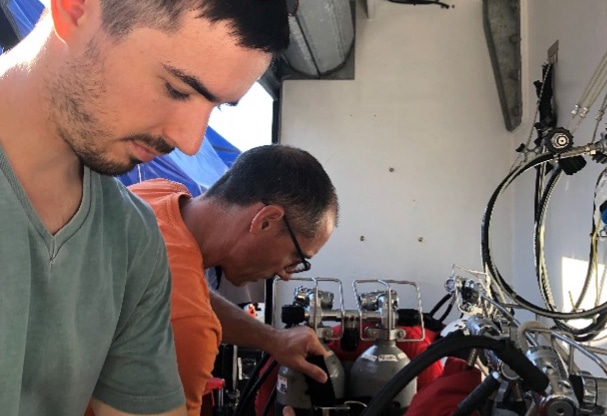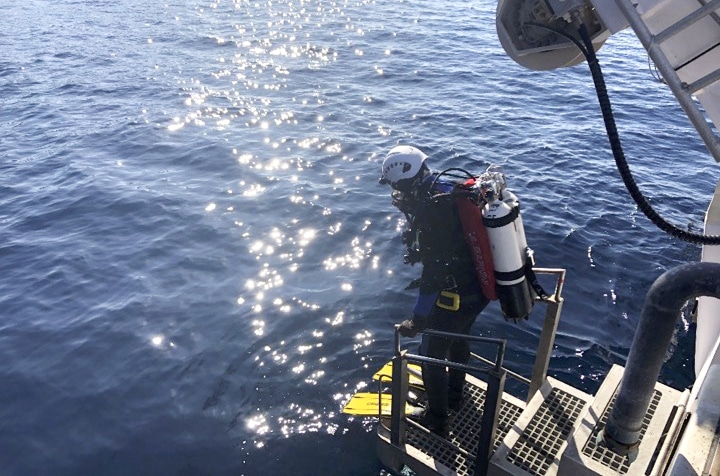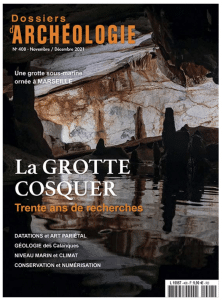FOCUS Hugo PELLET
In the Cosquer cave with Hugo PELLET, PhD student in the Resources, Hydrosystems and Carbonates team at CEREGE.

A Polytech engineering course
I trained as an engineer at Polytech Clermont (2-year degree in engineering sciences - mechatronics) and then did the engineering cycle at Polytech Marseille in mechanics and energy.
Following my end-of-study internship in 3D fluid simulation (CFD), I was recruited as a CFD engineer in the nuclear industry while looking for a thesis subject. Bruno ARFIB (CEREGE), Stéphanie TOURON (Laboratoire de Recherche des Monuments Historiques) and Pierre HENRY (CEREGE) offered me the opportunity to work on the following subject: the dynamics of air and water flows in a coastal karstic carbonate massif and the impact on the alteration of the walls: application to the Cosquer cave and the state of conservation of its walls and works of art.
The aim of this thesis is to model the air and water flows in this karstic hydrosystem linked to the sea, in order to predict changes in water levels in the cave. The results should help inform the archaeological conservation choices to be made. To achieve this objective, it is necessary to understand the factors that control variations in air pressure and water level.
This subject is based on hydro-climatic data (air pressure, temperature, water level, water conductivity, humidity, etc.) measured with probes placed in the cave since 2014, supplemented with meteorological and oceanographic data. Hydroclimatic monitoring of the Cosquer cave has continued and expanded throughout my thesis.
I also spent part of the first year of my thesis being trained, particularly in diving, so that I could work on this sensitive site and take part in the organisation of large-scale logistics: boat, professional divers, fire brigade, administrative authorisations, checking and monitoring weather conditions, etc.

Subject of thesisHugo PELLET
Air and water flows in a coastal karstic carbonate massif and impact on the alteration of the walls: application to the Cosquer cave and the state of conservation of its walls and works.
With the financial support ofAMUthe LRMH and theARKAIA Institute.
CEREGE Geoarchaeology and Archaeometry transverse research area
Publication
Mesoscale permeability variations estimated from natural airflows in the decorated Cosquer Cave (SE France), EGU SphereHESS, 4 Sept. 2024
Hugo Pellet, Bruno Arfib, Pierre HenryStéphanie Touron, and Ghislain Gassier
Highlight HESS - Editor's choice :
"The subject of the paper is well outside the mainstream, and interesting for its methodological approach, the way it connects cave hydrology to air permeability of sedimentary rock, and the relevance for the protection (or lack thereof) of prehistoric cave art.
The missions at the Grotte Cosquer
At least once or twice a year, work is carried out in the cave to recover data and check that the equipment is working properly. If a probe breaks down without our knowledge, that's a lot of data lost during the period of inactivity.
From l'Estaque or la Joliette, the hour's sail to the site on the new archaeological research vessel Alfred Merlin gave us time to finalise our preparations and enjoy a light meal so we didn't go diving on an empty stomach. Once on site, we put on our wetsuits and got in the water.
The dive to the cave only takes about ten minutes. The team of professional divers ensure our safety and the transport of our computer equipment, carefully packed in watertight containers and bags.
The context of the Cosquer cave implies extreme conditions and environment for the material. It is subject to significant pressure variations, constant humidity and the salt attacked by the sea. As a result, it is not uncommon for some equipment to break down. As the time spent underground is limited to around 4/5 hours, we have to anticipate any problems and set precise objectives, as there is no way of getting there and back once we're underground.
Data recovery is a very long process: some probes take 20 minutes! Spot measurements are taken to check the quality of the data collected, and photos are taken to check changes in water levels in the cave. Everything is meticulously recorded in a notebook for reference in the event of a problem, or if a probe needs to be changed or moved.
After the fieldwork, most of the work is done on the computer, to clean up, format and combine all the newly acquired data, and then start to make practical use of it. This data is a mine of information about how the cave functions today. The length of the time series enables us to analyse how the system has evolved over time, and its links with the sea and the weather.
"The Cosquer cave is a unique and fragile heritage that must be protected, conserved and fully understood in order to preserve its memory and pass it on., Archaeology.culture.gouv
These data have made it possible to explore the geometry of the cave and the effects of precipitation on water level variations in the cave (see the publication HESS EGU Sphere)
These missions are part of the multidisciplinary project of the Grotte Cosquer research team headed by Cyril Montoya, supported by the Direction Régionale des Affaires Cultures (DRAC). The aims include reconstructing the history of the cave and the number of people who visit it, as well as creating a digital twin.
The Mysteries of the Cosquer Cave, Cyril Montoya, CNRS Le Journal.
Opening of the replica of the Cosquer cave
An evocation of the Cosquer cave is now open in Marseille, in the Villa Méditerranée. It consists of a reconstruction of six remarkable areas, known as the "scales" of the cave. Visitors can explore the cave on board exploration modules (small autonomous vehicles), in a cave interpretation centre, to discover the cave art and the unique archaeological and environmental context, with a particular focus on the rising waters.
Documentaries and articles about the Cosquer cave
. A masterpiece on borrowed time, documentary by Marie Thiry (Gédéon programme, Arte France, NHK) broadcast on Arte in 2022
. Cosquer cave Homo Sapiens and the sea, France 5 documentary on 21/03/2024.
. Cosquer, a cave under pressureActualité Région SUD
. Cosquer cave: the search continuesActualité Région SUD
Two organisations support the missions
Immadras Vanrell: based in La Pointe Rouge (Marseille), Luc and Orsane Vanrell's company provides rapid logistics support for missions.
The DRASSM (Research Department for Underwater and Submarine Archaeology of the Ministry of Culture dedicated to underwater archaeology): once a year, missions supervised by the DRASSM bring together the Grotte Cosquer research team: archaeologists, geomorphologists, hydrogeologists...




